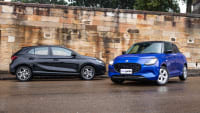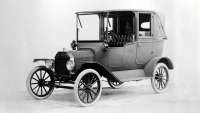As cycling becomes ever more popular, people are starting to look further afield to find places to ride. And to get there with their bikes, they need a way to carry them that’s safe and secure.
Bike transport has come a long way since the days of the gold Bike Beak perched precariously on the back of your parent’s VN Commodore – let’s take a look at a few of the newer systems out there.
What kind of rack should I look for?
.jpg)
Whether you want to carry a mountain bike or transport a road bike, the fundamentals are the same; it should be easy to use, and it should retain your bikes safely and securely – and keep them free from transport damage.
If you’ve got no room inside the car, then there are two places to carry bikes on a car; on the rear, or on the roof.
Towbar racks
.jpg)
Rear-mounted racks take many forms, and the most common is the tow-bar mount type. The old-school bike beak is still around, but they are limited to carrying three bikes at best, and the potential for scratching your bike is incredibly high.
A platform-style rear rack allows the bike’s wheels to rest on a running board, before the bike is secured in place. It makes loading bikes far easier, and it greatly reduces the chances of scratching your bike on the rack. You still need to take care when mounting bikes, though; 50km of a brake lever rubbing on a bike frame will do real damage.
Platform rear racks often come equipped with a number plate board, while taillights and indicators are also becoming common. Most Australian states and territories require the rear number plate to be visible, and a bike rack number plate holder allows you to either temporarily relocate your plate, or affix an approved third plate – known as an accessory or auxiliary plate – so it can be clearly seen from behind. These plates cost between $30 and $40 depending on where you live. Note, too, that if you drive at night, the plate must be illuminated.
If you really need to carry five bikes, Thule actually makes a beak-style rack that can hold that many bikes, but it uses a square hitch instead of a towball mount.
Hatchback racks
While having a tow bar for is the easiest way to mount a rear bike rack, it’s not a prerequisite. Brands like Thule sell detachable racks that rest on the rear of a sedan or hatchback, which can carry up to three bikes – though we’d definitely recommend carrying no more than two.
These racks use straps and hooks to attach to cars, and can be quite tricky to set up. As well, they work best with ‘regular’ bikes; step-thru frames and unusually shaped front triangles can be a challenge to sort out.
Roof-mounted bike racks
.jpg)
These racks take several forms; the most popular style currently doesn’t require you to remove the bike’s front wheel, instead it uses a clamp that secures the bike’s frame to the rack and wheel straps to stabilise the load. A typical wagon can fit three of these racks across the top of the car comfortably, though a large SUV could carry four racing bikes on the roof in a pinch.
The style of roof rack which requires the removal of the front wheel of the bike still exists, but it’s being made redundant thanks to bike technology. A mountain bike, for example, can have one of three different axle types, while racing bikes are starting to follow suit with two styles gaining popularity. This makes securing the front fork to the roof rack a bit of a gamble, especially if you want to transport a friend’s bike.
Thule does sell a front-wheel-off rack that can adapt to various front-axle types, but make sure you keep the adapters in a safe place – the glovebox is a good start!
Ute bike racks
Finally, if you have a dual-cab ute or similar vehicle, there are two main ways to secure your bike, outside of simply placing it in the tray and using a tie-down strap! The first is via a tailgate pad, which allows the bike to be draped over the tailgate and secured to the pad via Velcro straps. Depending on the size of the ute, it’s possible to transport up to five large mountain bikes this way.
It’s also possible to mount bike roof-racks onto either the floor of the tub, or indeed onto a hard tonneau cover.
Pros and cons
.jpg)
Obviously, the safest way to carry your bike is inside your car. It’ll stay out of the elements, you don’t run the risk of ramming it into something behind you or something above you, and it’s easier to keep it secure.
Failing that, the pros of each rack system differ. A towbar rack will keep the bikes out of the slipstream, for example, and doesn’t restrict the vehicle from entering garages or carparks.
The roof-rack mount means you have unrestricted access to the rear of the car, and it’s the easiest way to load and unload a bike – though tall SUVs and short bike riders sometimes don’t mix!
Hatch systems are good for occasional users with lighter bikes.
.jpg)
Pros with a rear-mounted system include an increased exposure to transport damage, while the added complication of extra number plates and lights can be a pain.
As well, don’t hang your bike tyre in front of your car’s exhaust pipe. Don’t ask how we know that.
The cons of a roof-rack-mounted bike rack include additional wind noise at speed, the bike’s great exposure to the elements – the gear shifter mechanisms, for example, are expensive and relatively fragile – and the increased risk of simply forgetting the bikes are there and hitting a low-hanging awning or roof.
.jpg)
Summary
There are a myriad of bike-carrying systems on the market to suit virtually every car on the road, so do your research before committing to a system. It’s worth noting that most systems, even roof-mounted ones, can be transferred between cars, so invest wisely.
Carsguide Adventure's Top 5 Bike-Carrying Tips:
Make sure your rear number plate is visible. Hand-printed plates aren’t generally accepted by police.
Make extra sure there is no metal-to-metal contact after the bikes are installed. Strategically placed cardboard scraps held on with electrical tape will keep things safe, as will Velcro straps and bike-packing foam – available from all bike shops for free and reusable forever.
Periodically check straps and levers every two hours on a long journey to make sure they are still snug.
A cheap coiled cable lock from a hardware store will give you peace of mind during a lunch stop.
If you have a wheel-off rack… don’t forget to put the removed wheel in your car. You’d be amazed how often that is overlooked.
Price range
Bike beak $100-$150
Rear-mounted three-bike platform rack $570-$1200
2 x roof bike rack system (front wheel off style) $510-$760
2 x roof bike rack system (clamp style) $370-$660







.jpg)
.jpg)



.jpg)
.jpg)

.jpg)


.jpg)





